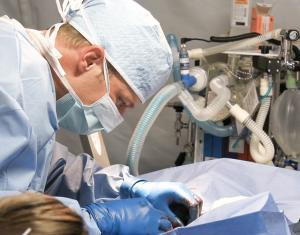Spay and Neuters: Why do some places charge such different fees for the “same” service?
- posted: Aug. 22, 2017
Spay and Neuters: Why do some places charge such different fees for the “same” service?
By Jim Young – Manager, Bellalago Veterinary Hospital
“Why is [fill-in-the-name of a service] cost that here and cost this down the street?” We get this sort of question frequently. I know what’s happening. I call around for large ticket items all the time. I Google, check Amazon, Yahoo Shopping, and call local stores before I buy anything of value. When I do this, I always look at the exact same item across all of the different stores and shops. When an item is exactly the same regardless of where it is purchased, that item is called “fungible.” These items are completely interchangeable – often down to having the exact same barcode! Think of items like a gallon of milk, soup, gasoline, or paper towels. Yes, some people say one brand is better than another or look for certain attributes, but most people wouldn’t give it a second thought. Is the Wawa’s gasoline really that different from the RaceTrac? If one of the brands is cheaper or on sale, it is often the brand we buy with these fungible items. In the veterinary world, some of these fungible items include things like diets, toys, certain medications, cages, doggie bags, and cat litter.
 Veterinary services are different. Many, if not most, services are not fungible. While we might think that something as simple as a rabies shot should be identical regardless of what clinic gives it, that is seldom true. What I’m exploring in this series are the questions that owners need to ask when pricing around non-fungible services. What one quickly discovers is “you get what you pay for.” If you price shop these services, you need to know exactly what to ask in order to get comparable prices.
Veterinary services are different. Many, if not most, services are not fungible. While we might think that something as simple as a rabies shot should be identical regardless of what clinic gives it, that is seldom true. What I’m exploring in this series are the questions that owners need to ask when pricing around non-fungible services. What one quickly discovers is “you get what you pay for.” If you price shop these services, you need to know exactly what to ask in order to get comparable prices.
I want to feature different services so that owners can educate themselves about what is important, and ask the right questions. I know I did not know about these differences before I started working in the field. As someone who is thrifty, I would have called around and priced out services without knowing just how different those services really are. Even now as I call around to check our prices against our competitors, I feel like I have to play 20-Questions to get the answer. Don’t get me wrong. I don’t think that most other clinics and hospitals are trying to mislead me or trick me in to going there by telling me a low price. I honestly believe that most of the staff answering the phones don’t know the differences either. Receptionists are not usually medically trained, and do not know the ins and outs of creating a surgical estimate.
In this first installment, I want to explore why the prices of spays and neuters seem so different between different clinics and hospitals. Once you know this, you will know what sorts of questions to ask and why these differences are so important.
First, let me get this out of the way, I am not implying that other clinics and hospitals provide sub-standard care. Every clinic and hospital provides a different standard of care in order to meet the different needs found within the community. What is really at stake is what is right for your pet, for you, and for your pocketbook. There is always risk involved in all surgeries and even the most advanced hospitals with the most skilled staff experience complications. Spending more money may help lower the risk, but no amount of money will completely eliminate it!
Many of the low-cost clinics do not require bloodwork before surgery. In fact, some do not even offer it! We always include bloodwork in our estimates provided prior to surgery because bloodwork helps determine the risk for anesthetic, surgical, and post-operative complications. If bloodwork is not done and your pet has an underlying medical issue, your pet may be at additional risk up to and including death. Yet, bloodwork is expensive so low-cost clinics choose not to include/offer it in order to keep expenses down. It is up to the owner to determine if doing or not doing bloodwork is a risk they want to take. If bloodwork is done, then the cost goes up.
Many low-cost clinics do not place an IV catheter or provide IV fluids during surgery. This is an additional expense. Without getting too complicated, fluids keep blood pressure stable and the organs functioning properly. If this is not done, there may be organ damage and the organs can fail (typically this does not happen for days or even weeks after the surgery). We always place the IV catheter and provide fluids as appropriate. If an IV catheter is placed and IV fluids are given, then the cost goes up.
Many low-cost clinics save money by keeping a minimum of staff on hand. This means that animals may not be monitored at all times before, during, and after surgery. I have even heard stories of doctors/surgeons also performing exams during the surgery time. Complications can often occur right after surgery and without constant monitoring, these complications may not be immediately noticed. However, someone watching before, during, and after surgery, costs money. We monitor all our patients before, during, and after surgery. If you want this sort of monitoring, then the cost goes up.
Many low-cost clinics do not have a full, comprehensive physical exam with vet consultation prior to surgery. The veterinarian may not even be someone that you’ve met before let alone had the chance to ask questions and discuss the exam. When a veterinarian is performing 30-50 surgeries in a single day, that sort of service is out of the question. At best, many low-cost clinics provide a box on the check-in form where you can write your concerns. We always have an appointment prior to surgery. You get to meet with the veterinarian performing or assisting with the surgery, ask questions, and have all your concerns addressed. Additionally, the day of surgery, another exam is performed by the veterinarian to ensure that there have been no changes prior to the surgery which could endanger your pet. If you want this sort of accessibility to the veterinarian and pre-surgical exams, then the cost goes up.
 Many low-cost clinics save money by only keeping the absolutely-required equipment on hand. This often means that they are only monitoring the pulse and oxygen in the blood. These are important, but what about monitoring other vital signs as well? What about body temperature, for instance? These might indicate that there are complications and can result in long and difficult recoveries. We monitor these vital signs to ensure that any complications are caught right away and discomfort can be minimized. Beyond just the pulse and blood-oxygen levels, we monitor EKG and blood pressure. In addition, all of this is tracked on paper so that changes can be noted quickly and corrective measures taken. If you want these additional vital signs to be monitored, then the costs go up.
Many low-cost clinics save money by only keeping the absolutely-required equipment on hand. This often means that they are only monitoring the pulse and oxygen in the blood. These are important, but what about monitoring other vital signs as well? What about body temperature, for instance? These might indicate that there are complications and can result in long and difficult recoveries. We monitor these vital signs to ensure that any complications are caught right away and discomfort can be minimized. Beyond just the pulse and blood-oxygen levels, we monitor EKG and blood pressure. In addition, all of this is tracked on paper so that changes can be noted quickly and corrective measures taken. If you want these additional vital signs to be monitored, then the costs go up.
Many low-cost clinics do not do anything beyond the basic spay or neuter. If your pet is not a standard case and has a higher risk of complications (large/giant breeds, senior pets, brachycephalic dogs with “flat/smashed” faces like pugs, obese pets, dogs in-heat, pregnant, or aggressive pets), then the low-cost clinic may not be for you. They often standardize their procedures in to a “one-size-fits-all” sort of approach. This often does not take unique pet needs in to consideration. If there are complications, the owner often has to find another veterinarian to take care of them. We’ve seen several recently coming from one of the local low-cost clinic after incisions have reopened. The low-cost clinic doesn’t provide this sort of follow-up service. Some of these low-cost clinics do not even have the equipment on hand to handle complications. Each surgery we offer is customized to the patient in order to reduce possible complications and we’re here to follow-up whether there are issues or not. Of course, if you want this sort of customization, then the costs go up.
As you can see, spays and neuters are not fungible services. Different clinics and hospitals offer very different versions of the same service. While the low-cost options might be fine for many animals, they aren’t what most people think of when they think of what they want for their fur babies. Of course, some times the cost of a service is the most important factor and low-cost is the way to go. Finally, don’t forget that just because a veterinary clinic or hospital is more expensive, that doesn’t mean they offer these services!
Owners need to educate themselves and ask the right questions! Do you perform bloodwork? Do you provide IV fluids? What sort of monitoring is there? Will my pet get a comprehensive physical exam, a limited exam, any exam? Will I get to meet the doctor and talk to her/him prior to the surgery? What do you do in the event of an emergency? What type of follow-up do you provide? Does the surgery take my pet’s unique needs in to consideration? How?
In the end, pricing around services such as spays and neuters is kind of like trying to price around a four-door sedan. You’re going to get a different price from the BMW dealer than the used car lot down the street; however, there will be a big difference in what you get!
Location
Find us on the map
Bellalago Veterinary Hospital
3809 Pleasant Hill Rd
Kissimmee, FL 34746, US

